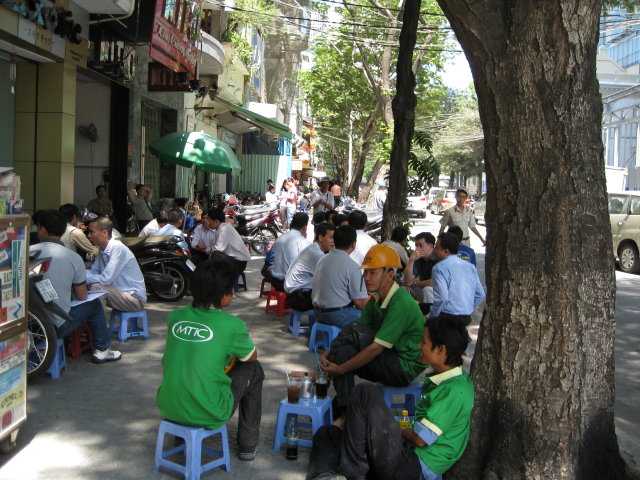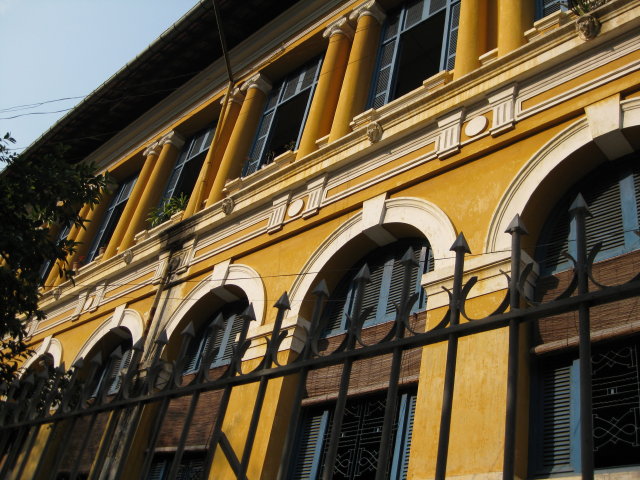As we head to Southeast Asia, or what used to be called Indochina, it is obvious that there will be no more cold or even mild weather. Everyone puts away winter clothes in the suitcases under our beds. We will be in the tropics for the duration of the voyage. A sure sign of that is not only the heat and humidity but also the fact that we must begin a course of malaria tablets beginning today and continuing through most of the remaining countries.
Saigon’s port is a relatively shallow one in what looks more like a narrow river—a mere channel of the Saigon River—and it feels as though the ship is very big for the draft. I later learn—while waiting in a queue at Angkor Wat behind an American couple—that there is an international consortium, including many American investors and engineers, who have begun negotiations and planning for a deep water port that will allow for much expanded trade. For now, the port is close to the historic center of the city and every kind of smaller fishing boats and commercial barges squeeze into the tight waterway. But even with a new port, it seems hard to imagine that export could be any more vigorous than it already is because the impression that the visitor immediately gets of Saigon is an almost phenomenal level of industry, commerce and traffic on the part of an amazing number and concentration of energetic people.
The population is one of the youngest anywhere in the world because many older people did not survive Vietnam’s many years of civil war. That also accounts for the fact that their memories of what is called here the “American War” are not personal. It seems difficult to believe, but Americans are warmly welcomed in Saigon and Hanoi, in addition to the rural areas. Saigon, in particular, is booming and growing by leaps and bounds, with bicycles and pedicabs now joined by vast numbers of motor bikes. (Rickshaws and trishaws are in many cases today powered by motor bikes and called “tuk tuks.”) Some of the miniature mopeds can be seen carrying as many as 5 people at a time. (The most unusual, but by no means rare, cycle drivers are shop girls in stiletto heels.) Every time you think you’ve seen the most outlandish cargo being balanced on a bicycle or motor bike, someone goes one better. In the two days I walk and ride around Saigon, the winner in my view is a man who balances not one but two twin beds on each side of his bicycle, making it ever so much safer (?) if he gets into an accident.
Only five years ago Saigon had almost no building more than four stories high. Today there are many taller office buildings under construction cheek by jowl with beautiful old French colonial structures—some of them the worse for wear but others undergoing restoration. The town hall, opera house and post office are original French colonial buildings that are now beautifully and thoroughly refurbished but fundraising is still going on to launch the repair of the historic old Notre Dame Cathedral and the many other temples across the city. As in so much of Asia, streets are places for both living and doing business with shops and markets of every kind. People from other countries sometimes fault Americans for eating while walking about and working. The Vietnamese, however, carry eating on the streets to a level that no one else comes close to. Entire families cook over braziers and picnic on small stools and long narrow tables on, of course, the “sidewalk” which, now that I think of it, is aptly named here because no one can walk abreast. If the sidewalks are a challenge to “walk,” however, crossing streets simply cannot be done without nerves of steel. The first piece of advice anyone gives the new tourist to Saigon is to venture across and continue at a steady pace so all of the traffic can safely dodge you. Easier said than done. Strikes me that Bill Cosby could do a fantastic comedy routine on the pedestrian braving the insane traffic. There are few lights. There are a few more curious intersections where everyone seems to yield to cross-traffic on an occasional basis, but apparently only the locals know what the cues for stopping and starting up again are. Worst of all are the ‘round-abouts where 6 or more avenues meet that we can blame on the French taste for grand boulevards and circles, I’m sure. At their centers are beautifully planted and meticulously cared for gardens and fountains that I cannot imagine getting to for the purpose of cleaning, watering and weeding at any time of the day or night. As a spectator sport, tourists stop and watch when little old ladies make it across the meshing cross-traffic without looking in any direction. Some friends and I cross a construction and traffic zone at night only to encounter concrete barriers that then everyone gets to climb over—at speed. Running hurdles in the city. The Vietnamese will enter this competition in the Olympics, I’m sure, and they will win.
Many of the photos I take in Saigon try to capture the rhythm and flow of the traffic but they really cannot. Instead, most of my fellow travelers take 2-minute movies that also capture the ceaseless honking and exhaust pipe noise of the many vehicles. I also take many photos of the shops and stalls all along the streets, especially the lively Dong Khoi Street, which also features many historical landmarks, and was the setting of Graham Greene’s The Quiet American. Produce is particularly good as bikes of all kinds transport fresh vegetables and fruit—many of them types we’ve never seen before—in to the city market stalls.
I eventually get to the Town Hall, Notre Dame Cathedral, the old Opera House (now Municipal Theater), and the General Post Office, all of these handsome French-colonial buildings near the city center. I am too late to get into the Reunification Palace, famous for the photograph of its front gate being charged by a North Vietnamese tank and from whose rooftop helipad the last President of South Vietnam was airlifted as the city fell to the Viet Cong. After walking for miles in the city, friends and I rest our weary feet, jangled nerves and parched throats in the rooftop bar of the Rex Hotel, known as a watering spot for foreign correspondents during the American War. It is only four stories high but captures breezes from the waterfront a few blocks away. Beer is almost everyone’s preferred drink, partly because we avoid water and ice since our digestive systems are unaccustomed to any local water outside the ship, but also because Asian beers are very good. Vietnamese beers seem particularly good and it turns out that the New York Times includes an article on exactly why that a few of us catch online after we leave Saigon. We agree with its findings in every respect.
That evening Nancy and Warner and I go back to the ship to strip from our sweat-drenched clothes, shower and change for dinner. Given the truly outstanding cuisines in the city we’re resolved to try a French restaurant. We settle on one but get lost trying to walk to find it. A couple of people—one a Vietnamese man who now lives in California and the other a strident local on a motor bike—try to help us find our way but then they get to arguing about which one knows what he’s talking about. We tell them we’re just going back to the ship to start over. (Directions and maps are only suggestions because there is so much construction everywhere that a usual route could be blocked at nearly any time.) On the way back we have several hairy adventures crossing heavy traffic in the dark. Later, armed with a better map from the ship library and a second choice of restaurant, we get to the destination just fine only to discover that the highly recommended restaurant has been demolished and is now yet another construction site. Thankfully, there is always Dong Khoi Street and so we go back to it and walk right in to a good meal at the Vietnam House. (Two days later, a French couple visiting Siem Reap tells me that they remember seeing me and many of the Semester at Sea students dining there. It is a very small world.)
We get back to the ship at a reasonable hour to sleep because I’ve got a departure time of 0530 for the trip to visit Cambodia and the temples of Angkor.









